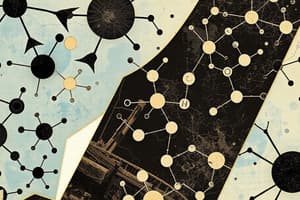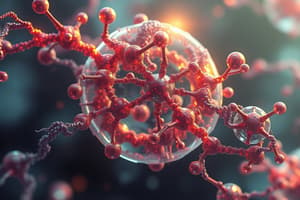Podcast
Questions and Answers
What characterizes prokaryotic cells compared to eukaryotic cells?
What characterizes prokaryotic cells compared to eukaryotic cells?
- Prokaryotic cells are usually larger than eukaryotic cells.
- Prokaryotic cells have extensive arrays of DNA.
- Prokaryotic cells lack membrane-enclosed organelles. (correct)
- Prokaryotic cells have a true nucleus.
Which of the following compounds were likely present in the early Earth's atmosphere?
Which of the following compounds were likely present in the early Earth's atmosphere?
- N2, H2O, O2
- O2, CH4, N2
- NH3, H2S, H2O (correct)
- H2, O3, CO2
What is the primary role of RNA in the theories of the origin of life?
What is the primary role of RNA in the theories of the origin of life?
- RNA is only a product of protein synthesis.
- RNA forms membranes for cells.
- RNA is considered the first genetic molecule. (correct)
- RNA acts solely as a catalyst.
How does the DNA structure differ between prokaryotic and eukaryotic cells?
How does the DNA structure differ between prokaryotic and eukaryotic cells?
What distinguishes the complexity of eukaryotic cells from prokaryotic cells?
What distinguishes the complexity of eukaryotic cells from prokaryotic cells?
Which statement about eukaryotic organisms is true?
Which statement about eukaryotic organisms is true?
What process is suggested as a potential method for biomolecule formation on early Earth?
What process is suggested as a potential method for biomolecule formation on early Earth?
Which of the following best describes eukaryotic cells?
Which of the following best describes eukaryotic cells?
What is the primary focus of biochemistry in relation to life?
What is the primary focus of biochemistry in relation to life?
Which of the following molecules are considered simple molecules that contributed to the origin of life?
Which of the following molecules are considered simple molecules that contributed to the origin of life?
What defines organic chemistry in the context of biochemistry?
What defines organic chemistry in the context of biochemistry?
Which statement best describes how living organisms achieve complexity?
Which statement best describes how living organisms achieve complexity?
Which aspect of biochemistry allows it to draw from various scientific disciplines?
Which aspect of biochemistry allows it to draw from various scientific disciplines?
What role do complex molecules play in living cells today?
What role do complex molecules play in living cells today?
Which of the following is NOT a fundamental molecule involved in biochemistry?
Which of the following is NOT a fundamental molecule involved in biochemistry?
What is a commonality among all living organisms?
What is a commonality among all living organisms?
What common feature do all amino acids share?
What common feature do all amino acids share?
Which statement accurately describes carbohydrates?
Which statement accurately describes carbohydrates?
What is the function of nucleotides in living organisms?
What is the function of nucleotides in living organisms?
What distinguishes lipids from the other biochemical classes?
What distinguishes lipids from the other biochemical classes?
What discovery challenged the belief regarding the origin of organic compounds?
What discovery challenged the belief regarding the origin of organic compounds?
What role do functional groups play in organic chemistry?
What role do functional groups play in organic chemistry?
Which of the following is NOT a characteristic of carbohydrates?
Which of the following is NOT a characteristic of carbohydrates?
What is the primary molecular currency of the cell?
What is the primary molecular currency of the cell?
Flashcards
What is biochemistry?
What is biochemistry?
The study of the chemistry of life, combining biology and chemistry to understand the molecular processes of living organisms.
What do all living things have in common?
What do all living things have in common?
Living organisms, despite their diversity, share fundamental features. Biochemistry reveals these unifying principles at the molecular level.
How did life begin?
How did life begin?
The origin of life on Earth is traced back to the formation of simple molecules like water, methane, and ammonia from atoms. These then reacted to create more complex molecules, leading to the first living cells.
What is organic chemistry?
What is organic chemistry?
Signup and view all the flashcards
What are biomolecules?
What are biomolecules?
Signup and view all the flashcards
What are functional groups in biochemistry?
What are functional groups in biochemistry?
Signup and view all the flashcards
Amino Acids
Amino Acids
Signup and view all the flashcards
Carbohydrates
Carbohydrates
Signup and view all the flashcards
Nucleotides
Nucleotides
Signup and view all the flashcards
Lipids
Lipids
Signup and view all the flashcards
Wöhler's Synthesis
Wöhler's Synthesis
Signup and view all the flashcards
Organic Chemistry
Organic Chemistry
Signup and view all the flashcards
Big Bang Theory
Big Bang Theory
Signup and view all the flashcards
Primordial Fireball
Primordial Fireball
Signup and view all the flashcards
Abiotic Synthesis
Abiotic Synthesis
Signup and view all the flashcards
RNA World Hypothesis
RNA World Hypothesis
Signup and view all the flashcards
Hydrothermal Vent Theory
Hydrothermal Vent Theory
Signup and view all the flashcards
Prokaryote
Prokaryote
Signup and view all the flashcards
Eukaryote
Eukaryote
Signup and view all the flashcards
Nuclear Region
Nuclear Region
Signup and view all the flashcards
Cyanobacteria
Cyanobacteria
Signup and view all the flashcards
Macromolecules
Macromolecules
Signup and view all the flashcards
Study Notes
Biochemistry and the Organization of Cells
- Biochemistry is the chemistry of life, combining biology and chemistry.
- Living organisms use similar biomolecules and energy.
Chemical Foundations of Biochemistry
- Organic chemistry studies carbon compounds, crucial for biomolecules.
- Biomolecules are categorized into four main groups: amino acids, carbohydrates, nucleotides, and lipids.
Amino Acids
- Amino acids are the simplest compounds.
- They contain an amino group, a carboxyl group, and a variable group (R-group).
Carbohydrates
- Carbohydrates are made of carbon, hydrogen, and oxygen (CH₂O)ₙ.
- Monosaccharides (sugars) are the simplest forms, with glucose being the most common.
Nucleotides
- Nucleotides are the building blocks of DNA and RNA.
- Adenosine triphosphate (ATP) is a crucial nucleotide, acting as the cellular energy currency.
Lipids
- Lipids are diverse, but generally insoluble in water (hydrophobic).
- Examples include fats, oils, and cholesterol.
Functional Groups
- Functional groups are groups of atoms that determine the properties of organic compounds.
- Many biologically important functional groups contain oxygen and nitrogen.
The Earth and Its Age
- Big bang cosmology is the prevailing theory for the origin of the universe.
- The Earth formed billions of years ago, and its early atmosphere was vastly different than now.
Molecules to Cells
- RNA was likely the first genetic molecule, with proteins likely developing later.
- Proteins and nucleic acids serve as catalysts and carriers of hereditary informa- tion, respectively.
- Membranes, formed by lipids, compartmentalize these molecules and act as essen- tial cellular boundaries.
Prokaryotes and Eukaryotes
- Prokaryotic cells (bacteria and archaea) lack a nucleus and membrane-bound organelles.
- Eukaryotic cells (animals, plants, fungi, protists) have a nucleus and membrane- bound organelles.
- Key organelles include the nucleus, mitochondria, and chloroplasts. These have double membranes and their own DNA.
Extremophiles
- Extremophiles are organisms that thrive in extreme environments.
- Organisms found in extreme environments can still produce enzymes that function in non-extreme conditions.
Studying That Suits You
Use AI to generate personalized quizzes and flashcards to suit your learning preferences.




